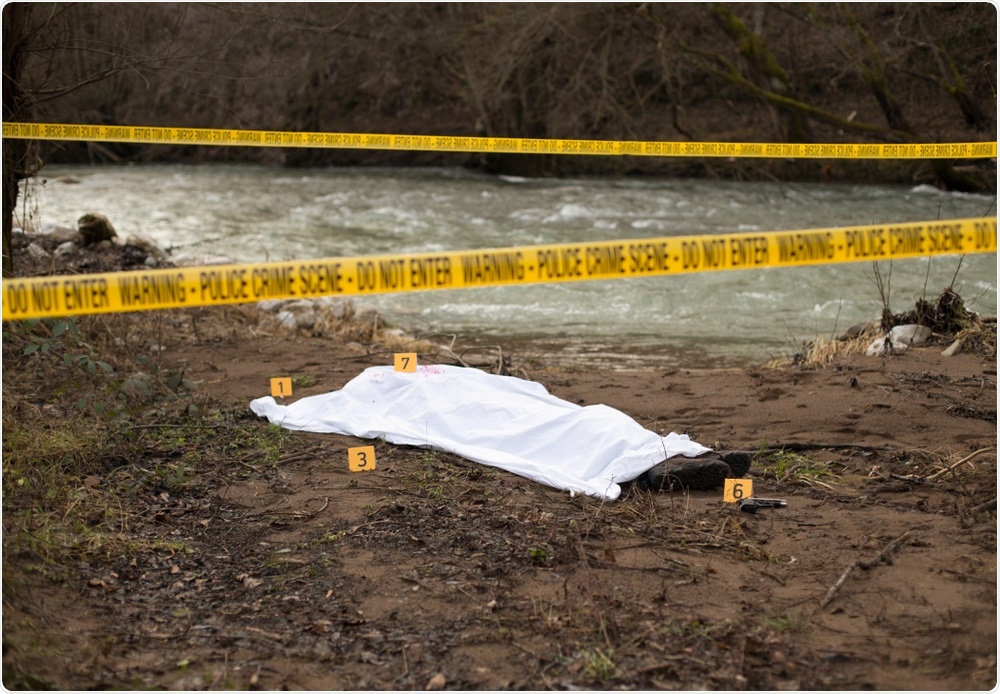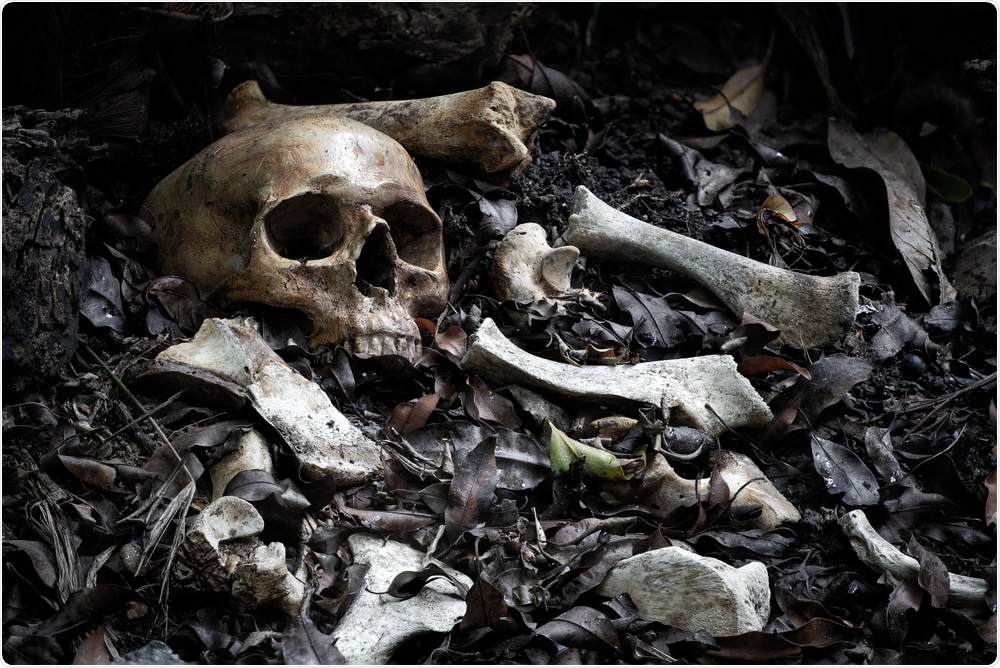In this interview, AZoLifeSciences speaks to Dr. Noemi Procopio about her latest research which involved using bone proteomics to determine the length of time a corpse had been left underwater.
What inspired your career in forensic science and post-mortem intervals (PMI)?
I started to be interested in Forensic Science when I was fifteen. At secondary school, I became fascinated by DNA and the application of biology to forensic casework and immediately decided that I wanted to become a Forensic Biologist.
I studied Biotechnology and then I did an MSc in Molecular Biotechnology at the University of Turin to get closer to the world of laboratory analyses and genetics, as, in Italy, we do not have any specific undergraduate or postgraduate degree in Forensic Science. Then, I have been lucky enough to find a forensic geneticist who has offered to be my supervisor for my BSc and MSc theses, and I became even more aware that Forensic Biology was the right path for me.
I started to be more interested in PMI estimation and bones during my Ph.D. at the University of Manchester, where I did a project on the use of bone proteomics to estimate PMI and age-at-death. This was something relatively new for me, but it intrigued me that much that I decided to become an academic, to pursue my research objectives.

Underwater Corpse. Image Credit: Motortion Films/Shutterstock.com
What methods are currently available for the determination of postmortem submerged interval (PMSI), and what are their limitations?
The most popular method to determine PMSI is currently the evaluation of the total aquatic decomposition score (TADS), which is aimed at assessing the level of decomposition of several areas of the body, including face and neck, body and limbs, to obtain an estimation of the accumulated degree days (which is an estimation of the thermal energy needed to allow for the decomposition of the tissues post mortem, obtained combining the temperature at which the body is left to decompose and the passage of time) that is then used to estimate the PMSI.
The major problem is that these evaluations are based on the morphological appearance of the body, and can easily be affected by the expertise of the observer, by specific phenomena such as the presence of adipocere on the bodies or by the action of aquatic currents, the activity of marine animals, the concentration of salts, the temperature, and many other factors.
Overall, this limits the reliability and the consequent applicability of this approach in court, and for this reason, more research is needed to increase the accuracy of PMSI's estimations.
How do different aquatic environments affect decomposition and therefore the determination of PMSI?
The environment surrounding a body can strongly affect its decomposition rate, and so, the estimation of PMI and PMSI. As I previously mentioned, the presence of salts (and so, the type of water) can inhibit the bioerosion, which is the activity of decomposing bacteria, on the carcasses, resulting in a slower decomposition in comparison with terrestrial environments.
The temperature also affects the estimation of the PMSI, as aquatic environments are normally characterized by cooler and more stable temperatures than their terrestrial counterparts, overall delaying the decomposition process. The depth of submersion also affects the decomposition of a cadaver.
Moreover, the action of aquatic scavengers and water flow can accelerate the decomposition rate and the skeletonization process. Overall, estimating PMSI is even more complicated than PMI.

Body in River. Image Credit: Wulle/Shutterstock.com
Why is it important to be able to accurately identify the post-mortem interval of a corpse?
The precise estimation of PMI, or PMSI in case of submerged bodies, is essential to guide the investigations towards a correct interpretation of the circumstances of death and the facts surrounding suspicious deaths.
Knowing the exact PMI can corroborate or discredit someone’s allegations regarding a crime, can help in finding the perpetrators or in finding leads, in eliminating suspects with a good alibi for the time in which death occurred, and can assist in the identification of unknown victims found dead, particularly when there are missing individuals, suspected to be dead, for which the date of the last time they were seen alive or the date of presumed death is available.
Overall, a precise estimation of PMI is indispensable for a successful investigation.
What applications does proteomics have within forensic science?
The application of proteomics to forensic sciences is quite new, particularly due to the recent advances of analytical instruments, such as ultra-high-performance liquid chromatography (UHPLC) coupled with tandem mass spectrometry (MS/MS), that overall allows for a precise and accurate characterization and quantification of complex protein mixtures in biological and non-biological samples.
Proteomic analyses can be used to identify doping substances and drugs, to characterize the origin of different biological fluids found on a crime scene, such as semen and saliva or blood and menstrual blood, to understand the physio-pathological status of victims or aggressors starting from blood traces, and to conduct personal identification analyses starting from hair and bones where DNA fingerprint fails.
Proteomic analyses have been recently applied also to decomposing soft tissues, such as muscles, to identify biomarkers useful to estimate PMI.
Moreover, they are used on skeletal remains, to estimate both PMI and the chronological age of the victim, evaluate the presence of traumatic and violent events that generated the expression of specific protein markers, and to identify the presence of infectious and non-infectious diseases that could overall provide intelligence information to solve casework.
Can you describe how you carried out your research into using bone proteomics to determine PMSI?
The extremely limited availability of taphonomic studies of submerged cadavers, and the complete lack of proteomic studies on submerged bones, pushed me to apply bone proteomic analyses to bodies decomposing in aquatic environments. Being aware of the various variables able to affect the decomposition rates in water, I decided to keep fixed temperature and depth of water, and to exclude water currents and the presence of marine scavengers to focus the attention uniquely on the type of water and to the PMSI, and their effects on the bone proteomes of submerged mice.
This study was aimed at exploring the presence of protein biomarkers useful to determine PMSI and/or the type of water in which a body has been left to decompose, to provide useful information for the investigators, that could then be tested and eventually validated in studies with human carcasses.
For this reason, we used four different types of water commonly found in forensic contexts (seawater, chlorinated water from a pool, pond water, and tap water as a control) and we left several mice bodies to decompose up to three weeks. At specific time points, we collected the bodies (or the bones, depending on their decomposition stage), we isolated the bones of interest (in this case, tibiae) and we conducted proteomic analyses.
What did you discover?
We found that the type of water has a minor effect on the bone proteomes, which are influenced mostly by the PMSI instead. This allowed us to find a list of specific proteins significantly more or less abundant at specific PMIs (one or three weeks), showing overall great potential for future estimations of PMSIs using bone proteomics.
We observed a constant decrease of the muscle protein fructose-bisphosphate aldolase A in our specimens with increasing PMSIs, similarly to what we found previously with bodies in terrestrial environments, namely that muscle proteins decrease in their abundance due to their decay with prolonged times after death.
We also observed a significant decrease of a specific protein, peptidyl-prolyl cis−trans isomerase, between controls (left to decompose in a terrestrial environment) and the submerged bodies, together with another protein (coagulation factor VII) that was chemically modified only in terrestrial controls and not in the aquatic environments, and another one, fetuin-A, that was significantly more chemically modified in pond water compared to the other aquatic environments.
These results show the presence of potential biomarkers useful to determine the nature of the environment in which a body has been left post mortem, and that bone proteomics may be a promising tool to determine the type of water in cases involving the presence of submerged victims.

Research. Image Credit: Dr. Noemi Procopio
How accurate was your research at determining the PMSI of the corpses?
The nature of this study, which was intended to be a proof of concept of the application and usefulness of bone proteomics to submerged bodies, did not allow us to obtain a regression equation able to predict PMSI with a specific accuracy degree.
More replicates and more time points, ideally using human bodies, will be needed to obtain an equation, and a respective error rate, useful to predict PMSI. However, the fact that the proteomes were not affected in a significant way by the type of water in which they were submerged, but by the PMSI of the bodies, is very promising and should definitely stimulate more research in this direction, to test the accuracy of this methodology on human individuals and the post mortem intervals where this approach can be used, to finally make it applicable to real forensic contexts.
What role did mass spectrometry play within your research? What are the advantages of using mass spectrometry compared to other analytical techniques?
Mass spectrometry is currently the gold standard approach in proteomic research – in particular, the instrument that we used for this study, an Orbitrap LC-MS, is characterized by a high-resolution and an accurate mass performance that allows for the identification of proteins present also in low-abundance in the sample.
In comparison with previous analytical techniques available to conduct protein studies, such as protein electrophoresis followed by Western Blotting to identify proteins via immunoblotting, with mass spectrometry it is possible to perform untargeted analyses, which means essentially that there is no need to expect specific proteins to be present in the sample and to look for those.
This approach ultimately allows for the identification of new biomarkers, which is essential for this type of research.
Why are proteins found in bones more commonly used to determine PMSI than other proteins found within the body?
Bones, together with teeth, are among the types of living tissue that survive the longest in the body, due to their mineral matrix that protects their organic fraction from the decay driven by bacteria. For this reason, also the biomolecules contained within bones, such as proteins, DNA, and lipids can survive for prolonged times after death.
Scientists have found bone proteins within prehistoric specimens, such as in the femur of a 43,000-year-old mammoth, also where DNA was completely degraded. Although also other types of proteins, such as muscle or serum ones, can be useful to determine PMI, their survival is shorter than bone proteins. This means that they can be used to investigate relatively short PMIs and PMSIs (e.g., when soft tissues are still present), whereas bone proteins are ideal targets for prolonged times post mortem (e.g. during advanced decay and skeletonization stages).

Skull and Bones. Image Credit: tatui suwat/Shutterstock.com
Do you believe that your research will help enable other scientists to investigate the potential applications of bone proteomics?
Absolutely, the field of bone proteomics, particularly for forensic applications, is growing rapidly and is gaining more interest among scientists around the world.
Not only forensic scientists but also bioarcheologists and paleontologists are using bone proteomics to better understand the phenomena leading to the fossilization of bone specimens, the diagenesis, and decay of the bone tissue post mortem, and its survival in specific environmental conditions – and the submerged environment is one of the most intriguing ones, that deserves more attention and more experimental studies.
What are the next steps in your research into determining PSMI?
Well, at the moment the research I am conducting with my ForensOMICS Team at Northumbria University is focused predominantly on the discovery of bone biomarkers useful for terrestrial PMI and age-at-death estimations on human individuals, thanks to a prestigious Future Leaders Fellowship I received from the UKRI last year – but I do not exclude the possibility to expand this research also to submerged cadavers in controlled conditions, once the model for the PMI estimation in terrestrial environments would have been completely developed and validated.
Where can readers find more information?
Original manuscript - https://pubs.acs.org/doi/abs/10.1021/acs.jproteome.0c00060
Twitter - @SnowEmi - https://twitter.com/snowemi
Twitter - @ForensOMICS - https://twitter.com/ForensOMICS
About Dr. Noemi Procopio
Dr. Noemi Procopio is Principal Investigator and Senior Research Fellow in Forensic Sciences at Northumbria University (Newcastle, UK). She obtained her MSc in Molecular Biotechnology from the University of Turin (Italy, 2014) and a Ph.D. in Forensic Proteomics from the University of Manchester (UK) in 2018.
Straight after the Ph.D., she was appointed as Lecturer in Forensic Science at Northumbria University, and one year after she was awarded a prestigious UKRI Future Leaders Fellowship of £1.2M with a project titled “Forens-OMICS”: a cross-disciplinary implementation of omics sciences to in vivo and post-mortem aging investigations for forensic applications”.
The final goals are the identification of new biomarkers in human bones capable of revealing information on the chronological age and the post-mortem interval (PMI) of the individuals, for forensic purposes. This will be achieved through a multidisciplinary approach where “omics” methodologies and machine-learning tools will be integrated to develop predictive models for PMI and age-at-death estimations.
She has been recently appointed as “Visiting Professor” at the University of Eastern Piedmont (Novara, Italy). She is a member of the American Academy of Forensic Sciences, of the Italian Academy of Forensic Sciences, and the Chartered Society of Forensic Sciences.